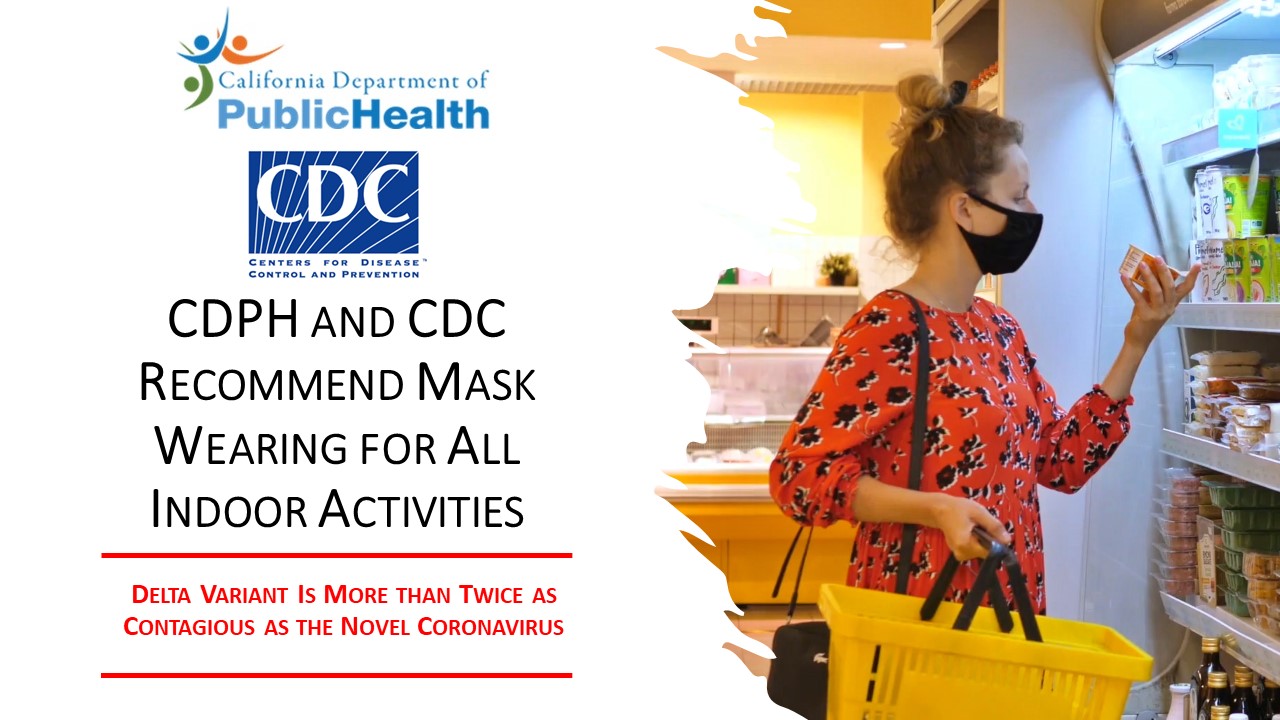Delta Variant Twice as Transmissible as Novel Coronavirus
The COVID-19 vaccines are effective in preventing serious disease. Unvaccinated persons are more likely to get infected and spread the virus which is transmitted through the air and concentrates indoors. About 15% of our population remains without the option for vaccination (children under 12 years old are not yet eligible) and risk for COVID-19 exposure and infection will remain until we reach full community immunity.
The purpose of this guidance is to provide information about higher risk settings where masks are required or recommended to prevent transmission to persons with higher risk of infection (e.g., unvaccinated or immunocompromised persons), to persons with prolonged, cumulative exposures (e.g., workers), or to persons whose vaccination status is unknown. When people who are not fully vaccinated wear a mask correctly, they protect others as well as themselves. Consistent and correct mask use by people who are not fully vaccinated is especially important indoors.
With the emergence of the more contagious Delta variant in California which now accounts for over 80% of cases sequenced, cases and hospitalizations of COVID-19 are rising throughout the state, especially amongst those that remain unvaccinated.
Despite ongoing outreach and improving COVID-19 vaccine access, as of July 27, 2021, a significant proportion of Californians throughout the state are not yet fully vaccinated. The Delta variant is two times as contagious than early COVID-19 variants, leading to increasing infections.
In California, unvaccinated persons continue to be required to wear masks in all indoor public settings. This guidance is an update, in light of review of the most recent CDC recommendations. To achieve universal masking in indoor public settings, we are recommending that fully vaccinated people also mask in indoor public settings across California. This adds an extra precautionary measure for all to reduce the transmission of COVID-19, especially in communities currently seeing the highest transmission rates. Local health jurisdictions may be more restrictive than this guidance.
In California, fully vaccinated people might choose to wear a mask in indoor non-public settings, particularly if they are immunocompromised or at increased risk for severe disease from COVID-19, or if they have someone in their household who is immunocompromised, at increased risk of severe disease, not fully vaccinated, or not yet eligible for vaccination.
In workplaces, employers are subject to the Cal/OSHA COVID-19 Emergency Temporary Standards (ETS) or in some workplaces the Cal/OSHA Aerosol Transmissible Diseases (ATD) Standard and should consult those regulations for additional applicable requirements.
Masking Requirements
Masks are required for all individuals in the following indoor settings, regardless of vaccination status:
- On public transit[1] (examples: airplanes, ships, ferries, trains, subways, buses, taxis, and ride-shares) and in transportation hubs (examples: airport, bus terminal, marina, train station, seaport or other port, subway station, or any other area that provides transportation)
- Indoors in K-12 schools[2], childcare[3]
- Emergency shelters[4] and cooling centers[5]
Masks are required for all individuals, in the following indoor settings, regardless of vaccination status (and surgical masks are recommended):
- Healthcare settings[6]
- State and local correctional facilities and detention centers[7]
- Homeless shelters[8]
- Long Term Care Settings[9] & Adult and Senior Care Facilities[10]
Additionally, masks are required* for unvaccinated individuals in indoor public settings and businesses (examples: retail, restaurants, theaters, family entertainment centers, meetings, state and local government offices serving the public).
See State Health Officer Order, issued on July 26, 2021, for a full list of high-risk congregate and other healthcare settings where surgical masks are required for unvaccinated workers, and recommendations for respirator use for unvaccinated workers in healthcare and long-term care facilities in situations or settings not covered by Cal OSHA ETS or ATD.
For additional information on types of masks, the most effective masks, and ensuring a well-fitted mask, individuals should refer to CDPH Get the Most out of Masking and see CDPH Masking Guidance Frequently Asked Questions for more information.
*Guidance for Businesses, Venue Operators or Hosts
In settings where masks are required only for unvaccinated individuals, businesses, venue operators or hosts may choose to:
- Provide information to all patrons, guests and attendees regarding vaccination requirements and allow vaccinated individuals to self-attest that they are in compliance prior to entry.
- Implement vaccine verification to determine whether individuals are required to wear a mask.
- Require all patrons to wear masks.
No person can be prevented from wearing a mask as a condition of participation in an activity or entry into a business.
Exemptions to masks requirements
The following individuals are exempt from wearing masks at all times:
- Persons younger than two years old. Very young children must not wear a mask because of the risk of suffocation.
- Persons with a medical condition, mental health condition, or disability that prevents wearing a mask. This includes persons with a medical condition for whom wearing a mask could obstruct breathing or who are unconscious, incapacitated, or otherwise unable to remove a mask without assistance.
- Persons who are hearing impaired, or communicating with a person who is hearing impaired, where the ability to see the mouth is essential for communication.
- Persons for whom wearing a mask would create a risk to the person related to their work, as determined by local, state, or federal regulators or workplace safety guidelines.
According to the CDC and leading health experts, your best defense to avoid getting severely ill from COVID-19 and the Delta variant is to get the FDA approved vaccines authorized for emergency use. To schedule a vaccination appointment, contact your medical provider or local pharmacy. To schedule an appointment through the Riverside County Department of Health, go to https://www.rivcoph.org/COVID-19-Vaccine or to learn about the safety of the vaccines, go to https://www.rivcoph.org/vaccine-safety or your medical provider. There are no more long lines, wait times, or the need to drive any far distance.

